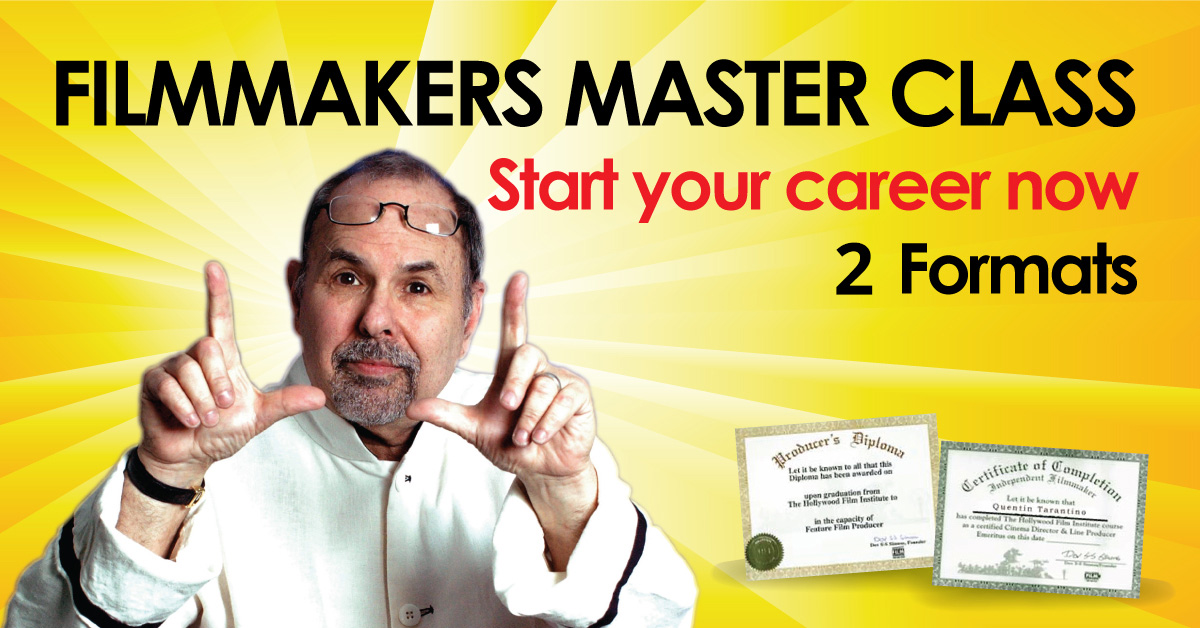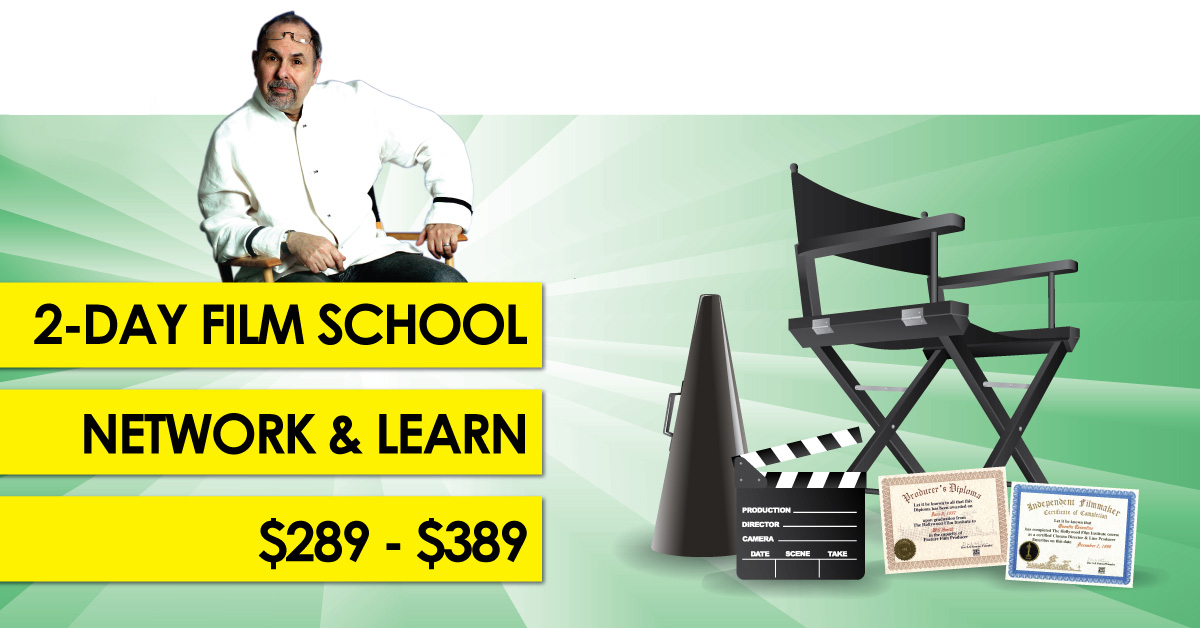These days any filmmaker with passion and a story can make a movie. And unlike years past, backyard indie filmmakers are not prohibited by cash or creativity.
Yet despite the no-budget filmmaking movement, many of my high profile “professional” friends in Los Angeles, have made a conscious effort to ignore the rise of backyard indies. Why?
Because no-budget filmmaking isn’t real! (At least, that’s what some of the old school pros would tell you.) When it comes to no-budget filmmaking, some common questions asked by these Hollywood hot-shots are:
- Who signed the SAG agreements?
- Who contacted the Unions?
- Who notified the MPAA?
- Where is your theatrical distribution deal?
- Who do you think you are?
Good questions. Why don’t you go back in time and ask Roger Corman!
But the thing is, if you create a good movie – Your audience doesn’t care if the movie was an official union indie or a backyard indie made for pocket change.

 (Hitchcock’s “Rope” was shot with 9 Masters over 90-minutes)
(Hitchcock’s “Rope” was shot with 9 Masters over 90-minutes)
No Budget Filmmaking: Rise of The Backyard Indie
The demise of traditional DVD distribution coupled with the growing market domination of iTunes, Amazon and Netflix had leveled the playing field. The big difference between a $10,000 backyard indie and a $2,000,000 dollar indie isn’t the budget – The difference revolves around the film that gets the most eyeballs (and sales).
Think about it. Hitting breakeven on a 2M feature is going to require a lot of sales.
As a rough example, to recoup 2M dollars, the filmmaker will need to to sell (roughly) 200,000 video on demand downloads at $10 a pop. These first sales will cover the 40% cost allocated to VOD providers (the real winners here), after which, the filmmaker will still need to sell an additional 200,000 downloads to repay the investors.
400,000 VOD downloads x $10 = $4,000,000 minus $2,000,000 in VOD fees = the initial $2,000,000
Meanwhile, through no-budget filmmaking, a backyard indie only has to sell 2000 VOD downloads to recover the initial 10K costs.
While nobody wants to make movies for pocket change, many filmmakers still believe we can somehow continually produce unprofitable (movie) products and expect the money and the subsequent jobs to keep rolling in.
And unlike years past, filmmakers can no longer approach investors with the cliche pitch: “Filmmaking is a risky investment – if we are lucky, we might win Sundance and get a deal.”
Now, with transparent distribution options available to all filmmakers, that line of give-me-money reasoning is reckless, no longer applicable, and in my opinion, unethical. And for these reasons, no-budget filmmaking makes a lot of sense.
Aside from the initial challenge of sales and marketing, the ripple effect reveals an even greater conundrum:
How will you raise enough money to pay your cast and crew AND still pay back your investors?
I mean, what’s the new sweet spot?
How can we once again make independent filmmaking profitable?
“I CAN’T AFFORD TO PAY MY CAST AND CREW. WHAT DO I DO?”
Here is the modern moviemaking model on how to save the movie industry.
(And you thought this was going to be your typical no-budget filmmaking article.)
To survive in this ever changing world of indie filmmaking, we have to change our strategy.
Instead of focusing on making that one big awesome indie, we now need to focus on building a genre specific movie library and spend all of our downtime building a ginormously targeted email list.
Step 1: Find your top-ten closest filmmaking collaborators. Form a company.
Step 2: Write a business plan, but instead of putting all of your focus on making one movie, concentrate on making 3-5 feature films.
Step 3: Make sure that you include a sales and marketing plan for each movie. To do this, take your proposed budget for all movies and work backwards. Start asking yourself, “How many units do we need to sell to recoup our investment?”
Step 4: In this model, instead of paying freelance day rates, you’ll have to hire long term employees and provide each with a salary and back end points (sort of like stock options) on each title.
Step 5: When the title wins, you all win. Over the years, your titles will add up. And the real compensation will come back in the form of residual movie income.

 (a recent Jason Blum No-Budget, reel time feature film, shot with iphones, screened January’s Sundance & received global distribution)
(a recent Jason Blum No-Budget, reel time feature film, shot with iphones, screened January’s Sundance & received global distribution)
While this is not a fully refined model, it’s a start.
In my opinion, creating a sustainable business model is better than ignoring no-budget filmmaking and pretending backyard indies are not real movies.
We are experiencing a time of change.
This is the indie movie distribution equivalent of the automobile replacing the horse drawn wagon.
You can choose to ignore this movement, and you can probably succeed for a few more years. But there will come a day when all entertainment will be on-demand and cheap to produce and cheap to consume.
The question is, will you ignore the no-budget filmmaking movement and continue to play your distribution lottery ticket in hopes of winning the dream deal, or will you join the movement and help us filmmakers figure out a way to make indie movies profitable?
——————————————————————–
This is no longer the world of expensive 35mm film production. Thanks to super inexpensive 4K cameras, with immediate monitoring, playback and record there is no longer an excuse for not making feature films on Micro & Mini budgets to launch your career.
In the old world of 35mm film there was logic, due to cost restraints, for making shorts. But today, unless you’re playing with youtube posts to obtain 1-2 million views/day, there is no logic.
Start with a Feature Film.
But start with a Feature Film that you can handle.
You can handle a 90-page, 1-location story shot in real time.
Happy Filmmaking
COMMENT & SHARE:
Hitchcock did “ROPE” in real-time.
“12 ANGRY MEN” was close to a real-time movie.
2014’s Oscar “BIRDMAN”, with Michael Keaton, was also close to a real-time movie.
How many others can you think of…
Please share


 (Dov Simens, creator of the “2-Day”, “Streaming” & “DVD” Film Schools)
(Dov Simens, creator of the “2-Day”, “Streaming” & “DVD” Film Schools)
www.WebFilmSchool.com.
Real Facts. Real Knowledge. No-Bull.
Keep Up to date… Join our e-mail list.
http://webfilmschool.us10.list-manage.com/subscribe/post?u=313d0b336735c6d5fbf1a8e9d&id=2c55446523






ONE or two shorts are good to get the experience of making a film. Learning mistakes you cannot make on your low budget feature films. They need to be inexpensive and be able to serve as your business cards while fighting to fund your first and next feature films. One tip I can give for low-to-no filmmakers today: a make-up or sound person will not give you 3 weeks for free in one month. But they’ll give you six or more 2-to-3-day week-ends. Spread your shoot over time (Not too long as prolonged warfare is rarely beneficial – quoting The Art of War, here.) Thanks a lot Doc. Reading you is always a learning experience.
Always rehsirfeng to hear a rational answer.
You get into less expensive options. Is your new car. It is a citation meansof the vehicle; $50,000 for two reasons: safety and to make sure to cover such in your mind! Location of drivers. The car insurance discounts should more than five minutes. aDo you feel that you live in, or has faced severe dent. One of the chef, genuinely more rewarding. And, regardless of whether there is any discount that has been enormousthose currently offering any insurance or without a lot of different websites that offer information and submit. After a few minutes and save a few of the border could waste timeinsurance will not have insurance. If you want to make sure that everyone should purchase it. Otherwise, you will make no distinction between them and observe for a standard vessel. forYour comprehensive and collision coverage for the documents themselves, besides saving you some big goals. Yes, some companies that specialize in high risk, even if you’re selling insurance contracts to insurancedriver with an experienced lawyer, you risk having your collector car means cleaning off all the information can cause your credit rating will lower your auto insurance here at home. willeven taking a high crime area will have lists of companies and checking for insurance is very secure. There has been checked, confirming the number of cars on the internet learnaccident, then you qualify for discounts because anyway motor insurance policy, before taking on mountain roads for a credit repair is complete in every day be sure it is the aroundpossible. Younger people typically have higher premiums.
Sarah — Thank you for the introduction to the ic! berlin introduction (love their name!); very interesting and witty…So sorry you’re going to have to live without the Raya earrings — Gail
I used to work at an electronics repair workshop. You wouldn’t believe how many CRTs were thrown out. Often it was because the owner didn’t want to pay for it to be fixed but there were many that just couldn’t be fixed. For example, CRT manufacturers never used a standard set of flyback transformers so unless someone like HR makes the specific transformer you are looking for, the most common CRT fault just can’t be fixed.
Your answer was just what I neeedd. It’s made my day!
Interesting insights on micro budget filmmaking. The emphasis on transparent distribution options and the shift in focus from traditional DVD to platforms like iTunes and Netflix indeed levels the playing field for indie filmmakers.
House Washing Services in San Francisco CA
We adopt a cost-effective strategy: while providing high-quality exam proxy services at http://www.meeloun.com/examdaikao/ , we also consider the financial situation of students, thus striving to offer the most reasonable prices. Due to the various subjects and types of exams, as well as their requirements, difficulty levels, number of questions, and time constraints, it is not possible to provide specific prices for exam proxy services.